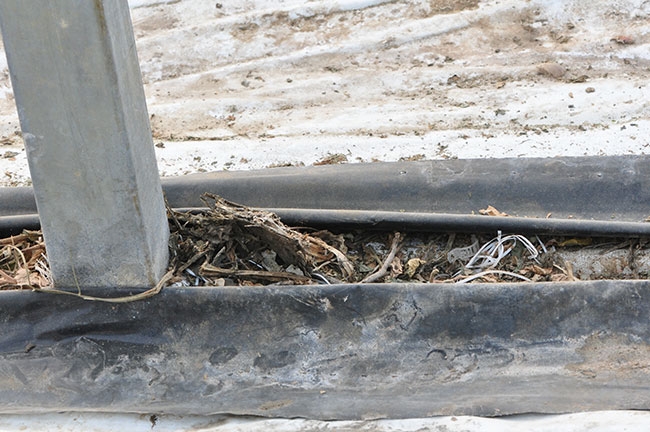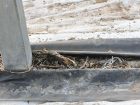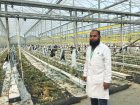
News
A Clean Sweep to End the Growing Season
After harvest ends, it’s time to refresh and start anew … a great way to keep pests at bay.
November 1, 2017 By Dr. M. Ishtiaq Rao
 Even with a great clean-out, cracks and crevices will host pests throughout the winter.
Even with a great clean-out, cracks and crevices will host pests throughout the winter. November 2017 – At this time of year, most greenhouse vegetable growers would have clean-out and preparation for the next season foremost on their minds. This is indeed a daunting task if the job is to be properly done.
Even though it is a subject that most growers are very familiar with, some key principles bear repeating or highlighting as a reminder. Starting afresh with a clean greenhouse for the new season significantly helps in minimizing incidence of pests and diseases in the new crop. Extending the period during which the crop can be kept clean of all pests is key to having a productive, profitable season.
Some key principles for achieving a successful cleanup in the greenhouse are as follows:
End clean – When it comes to pest control at the end of the season, too many growers take the attitude, “Let it go, it’ll all be gone soon anyway!”
If only they paused to consider that no clean-out product or process is 100 per cent effective. No matter what, you could have easily five per cent of the pests carry over by hiding in cracks, crevices and other inevitable structural hiding places. The pest levels in the new crop would be much more manageable in the preceding case. Even preventive applications of biologicals would not be able to handle a heavy load of pests. Any expenses made toward keeping the crop clean right until the end is an investment in the next year’s crop.
Remove the sources of pests and disease – A greenhouse is never clean without the removal of all plant debris, weeds, and residues such as calcium deposits on drip lines and stakes. Having debris contributes to future problems by providing a protective cover for pathogens, like spores and virus particles, and a food source for insect pests. This is especially critical in the case of difficult-to-control pests such the pepper weevil.
At 10 C, adult pepper weevils can survive more than 100 days if food is available in the form of pepper stalks. Without food, those adults will not live more than 28 days at the same temperature.
Debris and residues can also harbour many disease-causing pathogens that can remain infective for a long time. Some of these include Tobacco mosaic virus, bacterial canker (Clavibacter michiganensis) Pythium, Botrytis and gummy stem blight (Didymella bryoniae).
The presence of debris can also reduce or neutralize the activity of disinfectants, thereby reducing their effectiveness. This results in wastage of money and time. We also need to remember that extra care is needed in cleaning concrete and wood structures because their surfaces are often rough and textured, enabling pockets of spore-laden dust and fine debris to accumulate on these surfaces over the season.
Removal of weeds is also essential because they can harbour common greenhouse viruses such as Cucumber mosaic virus, and pests such as aphids, thrips and whiteflies. Note that the barely visible egg stage of whiteflies is notoriously present on weeds. Unlike the adult stage, the egg stage is highly tolerant to low temperatures, being able to survive up to 15 days at -3 C, and as many as five days at -6 C.
So even though pests such as whiteflies do not diapause, they can still survive low temperatures through their cold-tolerant stages.
Hot enough to kill – Consideration of ambient temperatures during cleanup is particularly important because they can influence two vital aspects:
- The effectiveness of the disinfectants themselves.
- The susceptibility of pests to applied pest control products.
Regarding the influence of temperature on the efficacy of disinfectants, warmer temperatures generally result in better kill of viruses, for example, than lower temperatures. Research studies done in Ontario indicate that of eight commercially available disinfectants tested against viruses on different surfaces, the majority showed much greater effectiveness at 22 C than at 4 C. On the other hand, a few of the products were just as effective at 4 C. It would be best to consult distributors and manufacturers on this aspect of specific products.
Not only do warmer ambient temperatures contribute to better kill of disease organisms with disinfectants, they also achieve a better kill of insect pests. This is because the warmer the temperature, the higher their metabolic activity and the faster their development. At warm temperatures, adults of winged insects are more active and fly more, thus increasing their chances of coming into contact with pesticides. Warm temperatures also shorten the time needed to complete life stages and thereby hasten the emergence of active stages. Thus, eggs hatch more quickly into mobile, susceptible juveniles, and pupae complete development faster to the more vulnerable adult stage.
Are your disinfectants working? – One method of enhancing the effectiveness of disinfectants is to do a pre-wash. Studies in Ontario indicate that a wash with soap prior to application of the disinfectant will result in better kill of pathogens such as Cucumber green mottle mosaic virus and Pepino mosaic virus.
Another factor that we need to be mindful of is pH. Generally, effective disinfectants are at either end of the pH spectrum – that is, they may have a high pH (very alkaline) or they may have a low pH (very acidic). With this factor in mind, application of different products with different pHs in close succession may result in neutralizing the pH of either disinfectant and could therefore reduce the effectiveness of the products.
Growers should consult the distributor or manufacturer when selecting disinfectants for cleanup, should they decide to use more than one product. Furthermore, when mixing disinfectants with water, we need to check the hardness of the water, i.e. whether it has high levels of calcium and magnesium. Some disinfectants, particularly quaternary ammonium compounds, are deactivated by hard water.
For maximum effectiveness, disinfectants are ideally mixed in warm water and applied to dry surfaces. For optimum results, disinfectants should remain wet on the surfaces for 15 to 30 minutes.
Avoiding re-infestation – A common cause of re-infestation is improper disposal of crop debris. If disposal is done in an adjacent field, such plant debris should be immediately buried to a depth of at least 30 cm to minimize spread of any pests and disease organisms. Burying to such a depth also promotes microbial decomposition of the debris, and destruction of pests and disease-causing organisms. It is critical that plant debris are not left in open piles in the field because such piles could serve as a source of infestation for all surrounding greenhouse and field crops when warmer conditions return.
Following the painstaking process of cleaning and disinfecting the greenhouse, all growers strive to maintain the highest level of sanitation for as long as possible. To achieve this goal, growers have to clean and disinfect everywhere and everything, including the boiler room, packing houses, all heavy equipment, and tools used during crop production.
They also need to implement regular sanitation protocols that include strategic placement of disinfection boot trays, provision of shoe covers and coveralls for visitors, provision of dispensers for disinfection of hands, and gloves to ensure that plants are not accidentally touched with contaminated hands, etc.
A more comprehensive treatment of this subject is available in the factsheet produced by the Ontario Ministry of Agriculture, Food & Rural Affairs, entitled “Sanitation Guidelines for Management of Pests and Diseases of Greenhouse Vegetables” http://www.omafra.gov.on.ca/english/crops/facts/14-033.htm. It details the sanitation measures that should be implemented not only at the end of the season, but also when the crop is being established, and during the months of production.
Dr. M. Ishtiaq Rao, CEO of Crop Defenders Ltd., is a PhD in entomology who is dedicated to the eradication of horticultural pests through IPM methods. Crop Defenders Ltd. utilizes biological knowledge of pest and beneficial insect species in order to manage pests cost-effectively and in a way that is cohesive with a healthy environment. ishtiaq@cropdefenders.com
Print this page


